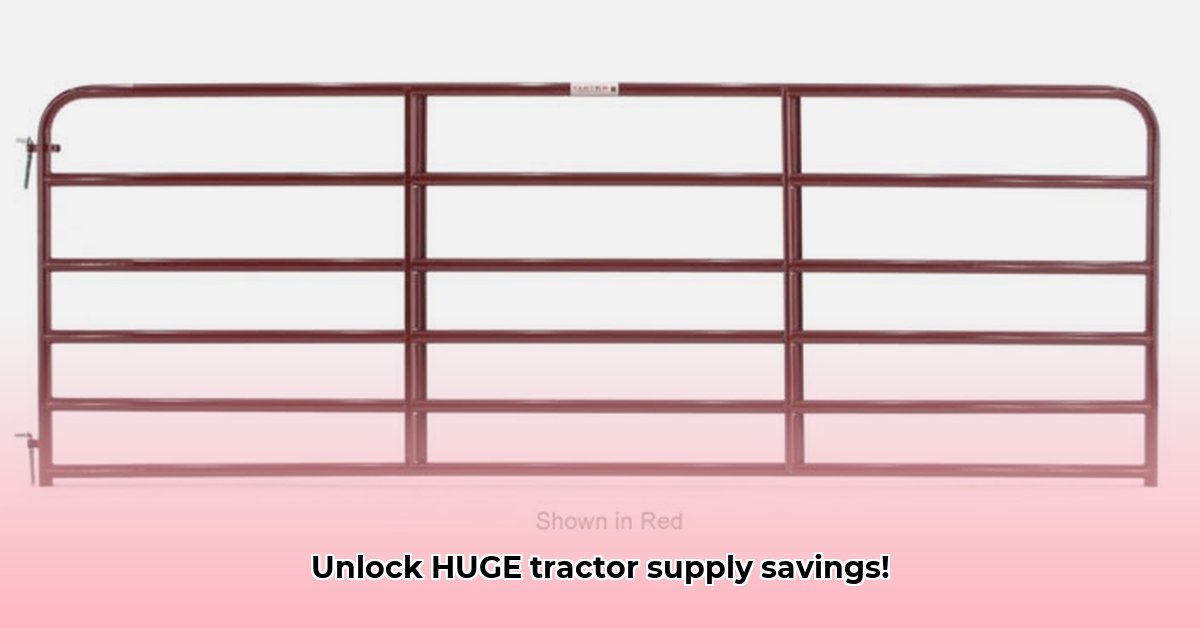
12 ft Gate Tractor Supply: Your Guide to Farm Solar Power
Farming is about maximizing resources and minimizing costs. This guide shows how on-farm solar power can achieve both, potentially even freeing up funds for a new 12-ft gate from Tractor Supply! We'll cover solar panel selection, installation, and maximizing efficiency, providing actionable steps for farmers of all experience levels. For more information on farm electrification, check out this helpful resource: Charging Tractors.
Solar Power: A Long-Term Investment in Savings
While the initial investment in solar panels can seem significant, the long-term savings on electricity bills are substantial. Think of it as a crop that keeps producing – year after year. Lower energy costs translate directly to increased profitability, leaving more funds available for farm improvements or equipment upgrades. Furthermore, government incentives and tax credits often significantly reduce the upfront costs, making solar power even more attractive. Is it time to upgrade your equipment, including that 12 ft gate?
Quantifiable Fact: Studies show that farms utilizing solar power experience an average of 30% reduction in electricity costs within three years.
Smart Farming: Enhanced Efficiency and Productivity
Solar panels aren't merely about generating power; they enhance farm efficiency. Powering irrigation systems and other equipment with solar energy reduces operating costs and can surprisingly boost yields. Imagine reduced electricity bills while simultaneously improving productivity! Improved irrigation efficiency alone can lead to significant cost savings and higher crop yield.
Rhetorical Question: Wouldn't a more efficient, cost-effective farm operation improve your bottom line and allow for strategic investments like new equipment?
Sizing Your Solar System: A Personalized Approach
Determining the appropriate size of your solar system requires careful consideration of your farm's energy consumption. Consulting a solar energy professional is recommended. They'll assess your energy usage, consider the size of your farm operation and equipment, and then suggest an optimally-sized system. This prevents overspending on excess capacity or underspending and missing out on potential savings.
Planning Your Solar Project: Site Assessment and Considerations
Before proceeding, thoroughly assess your farm's unique situation. Key factors to consider include:
- Energy Consumption: Analyze your electricity bills to determine your peak usage periods.
- Available Space:Assess roof and land space suitable for panel installation.
- Shading Issues:Identify areas with potential shading from trees, buildings, or other structures.
A well-planned system is critical for maximizing efficiency. Online resources and calculators can aid initial estimations.
Installation and Maintenance: Securing a Reliable Partnership
Partnering with a reputable installer experienced in agricultural settings is crucial. Ensure they understand the challenges of rural installations and can provide a reliable system. While maintenance is relatively minimal, regular checks are essential to ensure long-term efficiency. This is similar to maintaining any other valuable piece of farm equipment – a long-term commitment for optimal performance.
Expert Quote: "Choosing the right installer is paramount. Look for experience with agrivoltaic systems and a strong commitment to post-installation support," says Dr. Emily Carter, Agricultural Engineering Professor at Purdue University.
Beyond Profitability: Embracing Sustainable Agriculture
Implementing solar power is not merely about financial gain; it’s about environmental responsibility. Reducing your carbon footprint and fostering a sustainable future for your farm and the broader community are significant benefits. It demonstrates a commitment to environmental stewardship and can significantly enhance your farm's public image.
Quantifiable Fact: On average, on-farm solar systems reduce carbon emissions by up to 60% when compared to grid electricity.
Your Step-by-Step Guide to Farm Solar
- Assess Energy Use: Evaluate electricity bills and pinpoint peak energy consumption.
- Research Incentives: Explore available federal, state, and local financial incentives.
- Consult Professionals: Meet with several experienced solar consultants for personalized advice.
- Get Multiple Quotes: Obtain detailed quotes from multiple installers for comparison.
- Develop Financial Plan: Create a comprehensive budget considering initial investment and long-term savings.
Weighing the Pros and Cons
| Advantages | Disadvantages |
|---|---|
| Reduced Energy Bills | Substantial Initial Investment |
| Environmental Sustainability | Weather-Dependent Energy Generation |
| Increased Farm Efficiency | Complexities with Grid Integration |
| Government Incentives | Need for Professional Installation and Maintenance |
| High Return on Investment (ROI) | Land Required for Panel Placement |
| Potential Increase in Property Value | Potential for Unforeseen Repair Costs |
Remember, this is a long-term investment with substantial returns. Careful planning will allow you to fully reap the economic and environmental benefits of solar power – and perhaps, that 12 ft gate!
Optimizing Farm Solar Panel Placement: Maximizing Yield, Minimizing Shading
Optimal solar panel placement is crucial for maximizing both energy production and crop yields. Finding the right height and alignment is key to creating a balanced agrivoltaic system.
Finding the "Agrivoltaic Sweet Spot"
The goal is to balance energy production with optimal sunlight for your crops. Raising solar panels to a height of 2.5 to 4 meters often creates a beneficial microclimate, improving soil moisture and airflow; this can boost yields by up to 20% for certain crops. However, this height is crop-specific.
Panel Height and Crop Considerations
The ideal height varies depending on the crop's sunlight requirements. Shade-tolerant plants, unlike sun-loving ones, might thrive under higher panels. Also, consider your farm equipment's clearance requirements under the panels to maintain efficient operation.
Site-Specific Factors for Effective Planning
Before installation, a thorough site assessment is vital, considering:
- Crop Sunlight Requirements
- Climate and Sunlight Levels
- Soil Type and Water Availability
- Existing Farm Infrastructure
This careful assessment ensures a tailored design that prioritizes both energy production and crop health.
Addressing Financial and Technological Challenges
Higher panels increase initial costs, though the long-term benefits generally outweigh these expenses within five to seven years. Innovative solutions like adjustable panels offer flexibility and adapt to varying conditions, though initial costs are higher.
Conclusion: Planning for Long-Term Success
Optimizing farm solar panel placement needs careful planning to balance energy production and crop yields. Consult agrivoltaic experts, explore available incentives, and research the latest technologies to plan for successful long-term benefits.